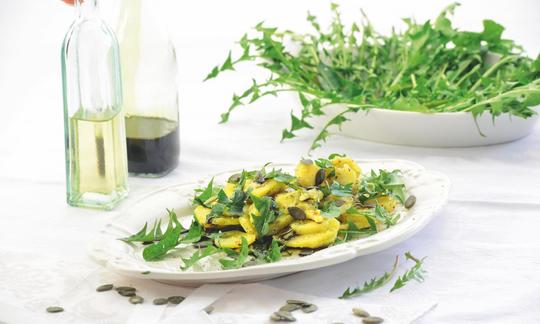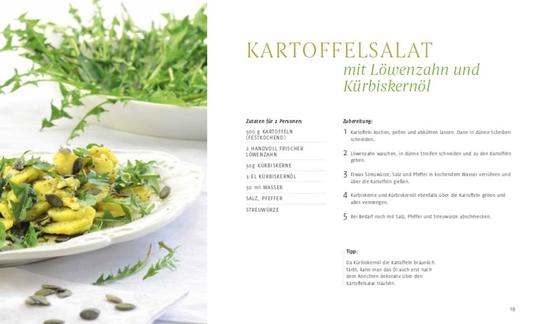Potato salad with dandelion and pumpkin seed oil
vegan
Ingredients (for servings, )
| 18 oz | Potatoes, white, raw |
| ⅓ oz | Dandelion, common (leaves, organic?) |
| 1 ¾ oz | Pumpkin seeds, dried, raw (organic?) |
| 3 tbsp | Pumpkin seed oil, Styrian (cold pressed?, raw?, organic?) (1.4 oz) |
| 50 ml | Vegetable broth without added salt (organic?) (1.7 oz) |
| 1 dash | Table salt (table salt, raw?, organic?) (0.01 oz) |
| 1 dash | Black pepper (organic?, raw?) (0.00 oz) |
Equipment
- stove
- saucepan
Type of preparation
- cook
- season to taste
- remove the skin
Preparation
Prepare potatoes
Boil potatoes, peel and let cool. Then cut into thin slices.Waxy potatoes are best.
You can continue with the other steps during the cooking process.
Prepare additional ingredients
Wash the dandelion, cut it into thin strips and add it to the potatoes.In the original recipe, 2 handfuls of dandelions are used for 2 portions.
Season vegetable stock with salt and pepper to taste.
In the original recipe, for 2 portions, instead of vegetable stock, "sprinkle seasoning dissolved in 50 ml of boiling water" (a vegan vegetable stock in powder form) is used.
Finishing the potato salad
Pour the broth, pumpkin seeds and pumpkin seed oil over the potatoes and mix everything together.If necessary, season with salt and pepper or vegetable stock.
Since pumpkin seed oil gives the potatoes a brownish color, you can also drizzle the oil decoratively over the potato salad after serving.
|
Nutritional Information per person
Convert per 100g
|
2000 kcal | |
|---|---|---|
| Energy | 500 kcal | 25.0% |
| Fat/Lipids | 33 g | 47.5% |
| Saturated Fats | 6.1 g | 30.4% |
| Carbohydrates (inc.dietary fiber) | 43 g | 15.9% |
| Sugars | 3.5 g | 3.8% |
| Fiber | 7.9 g | 31.5% |
| Protein/Albumin | 12 g | 24.1% |
| Cooking Salt (Na:127.1 mg) | 323 mg | 13.5% |
| Essential micronutrients with the highest proportions | per person | 2000 kcal | |
|---|---|---|---|
| Fat | Linoleic acid; LA; 18:2 omega-6 | 15 g | 152.0% |
| Vit | Vitamin K | 70 µg | 93.0% |
| Min | Manganese, Mn | 1.5 mg | 77.0% |
| Prot | Tryptophan (Trp, W) | 0.19 g | 76.0% |
| Elem | Phosphorus, P | 471 mg | 67.0% |
| Min | Copper, Cu | 0.64 mg | 64.0% |
| Elem | Potassium, K | 1'253 mg | 63.0% |
| Elem | Magnesium, Mg | 203 mg | 54.0% |
| Prot | Threonine (Thr, T) | 0.39 g | 42.0% |
| Vit | Vitamin B6 (pyridoxine) | 0.57 mg | 40.0% |
Detailed Nutritional Information per Person for this Recipe
The majority of the nutritional information comes from the USDA (US Department of Agriculture). This means that the information for natural products is often incomplete or only given within broader categories, whereas in most cases products made from these have more complete information displayed.
If we take flaxseed, for example, the important essential amino acid ALA (omega-3) is only included in an overarching category whereas for flaxseed oil ALA is listed specifically. In time, we will be able to change this, but it will require a lot of work. An “i” appears behind ingredients that have been adjusted and an explanation appears when you hover over this symbol.
For Erb Muesli, the original calculations resulted in 48 % of the daily requirement of ALA — but with the correction, we see that the muesli actually covers >100 % of the necessary recommendation for the omega-3 fatty acid ALA. Our goal is to eventually be able to compare the nutritional value of our recipes with those that are used in conventional western lifestyles.
| Essential fatty acids | per person | 2000 kcal |
|---|---|---|
| Linoleic acid; LA; 18:2 omega-6 | 15 g | 152.0% |
| Alpha-Linolenic acid; ALA; 18:3 omega-3 | 0.16 g | 8.0% |
| Essential amino acids | per person | 2000 kcal |
|---|---|---|
| Tryptophan (Trp, W) | 0.19 g | 76.0% |
| Threonine (Thr, T) | 0.39 g | 42.0% |
| Phenylalanine (Phe, F) | 0.60 g | 39.0% |
| Valine (Val, V) | 0.61 g | 38.0% |
| Isoleucine (Ile, I) | 0.46 g | 37.0% |
| Leucine (Leu, L) | 0.82 g | 34.0% |
| Lysine (Lys, K) | 0.54 g | 29.0% |
| Methionine (Met, M) | 0.22 g | 23.0% |
| Vitamins | per person | 2000 kcal |
|---|---|---|
| Vitamin K | 70 µg | 93.0% |
| Vitamin B6 (pyridoxine) | 0.57 mg | 40.0% |
| Vitamin C (ascorbic acid) | 26 mg | 32.0% |
| Folate, as the active form of folic acid (née vitamin B9 and | 63 µg | 31.0% |
| Niacin (née vitamin B3) | 4.0 mg | 25.0% |
| Thiamine (vitamin B1) | 0.26 mg | 24.0% |
| Pantothenic acid (vitamin B5) | 0.93 mg | 15.0% |
| Riboflavin (vitamin B2) | 0.14 mg | 10.0% |
| Vitamin E, as a-TEs | 0.79 mg | 7.0% |
| Vitamin A, as RAE | 50 µg | 6.0% |
| Biotin (ex vitamin B7, H) | 2.9 µg | 6.0% |
| Essential macroelements (macronutrients) | per person | 2000 kcal |
|---|---|---|
| Phosphorus, P | 471 mg | 67.0% |
| Potassium, K | 1'253 mg | 63.0% |
| Magnesium, Mg | 203 mg | 54.0% |
| Sodium, Na | 127 mg | 16.0% |
| Calcium, Ca | 47 mg | 6.0% |
| Essential trace elements (micronutrients) | per person | 2000 kcal |
|---|---|---|
| Manganese, Mn | 1.5 mg | 77.0% |
| Copper, Cu | 0.64 mg | 64.0% |
| Iron, Fe | 3.7 mg | 27.0% |
| Zinc, Zn | 2.7 mg | 27.0% |
| Selenium, Se | 3.1 µg | 6.0% |
| Iod, I (Jod, J) | 1.2 µg | 1.0% |
| Fluorine, F | 0.02 µg | < 0.1% |
Dandelion and pumpkin seed oil give this tasty potato salad its tart, nutty flavor.
Nutrient profile: According to GDA guidelines, one portion of this recipe covers more than 50% of the daily requirement of vitamin K, C and B6, potassium, manganese, phosphorus and copper.
Due to the content of pumpkin seeds and pumpkin seed oil, the ratio between omega-6 and omega-3 fatty acids is 99:1, which is significantly higher than the recommended maximum ratio of 5:1.
Health: For health reasons, we have created an alternative recipe with variations in the ingredients. Please read the link behind this motivation: Vegans often eat unhealthily. Avoidable nutritional errors .
Potatoes: The potato, which originally comes from South America, is one of the most important staple foods. Waxy potatoes are used for fried potatoes, gratins and potato salad, because the potatoes do not burst during cooking.
Dandelion: The fresh, young leaves of the dandelion are used raw in salads or as an ingredient in a smoothie, for example. The yellow flower can be used to make a syrup and the root to make a coffee substitute. Dandelion is also known to inhibit the growth of cancer cells.
Pumpkin seeds: The green, flat-oval pumpkin seeds are the seeds of the pumpkin and are available raw or roasted. Pumpkin seeds are rich in unsaturated fatty acids, vitamins and minerals, but contain a very poor ratio of omega-6 (LA) to omega-3 fatty acids (ALA) at 176:1.
Pumpkin seed oil: Pumpkin seed oil is made from roasted pumpkin seeds. It is used primarily as salad oil and in cold and warm dishes, but it is also useful for preparing desserts. The dark greenish-brown color and aromatic, nutty, spicy taste are characteristic of this specialty from Austria. When heated to over 100 °C, pumpkin seed oil loses its greenish color, its aromatic taste, some of its healthy ingredients and can even develop bitter substances.
Pumpkin seed oil has an antioxidant effect, which is due to the selenium and vitamin E it contains. As with all oils, we recommend moderate consumption.
Low-salt vegetable stock: We use extra low-salt vegetable stock to reduce the overall amount of salt without sacrificing flavor. Use your own preference as a guide when adding salt to this dish.
Since pumpkin seed oil gives the potatoes a brownish color, you can drizzle the oil decoratively over the potato salad after serving.
Do not peel potatoes: Since most of the vitamins are found under the skin, it is advisable not to peel the potatoes after cooking. In this case, it is best to use young potatoes with a smooth skin. Green spots on the skin indicate increased concentrations and should be cut out.
Remove and clean pumpkin seeds yourself : In general, the seeds of all edible pumpkins are suitable for consumption. The best way to remove as much of the pulp fibers as possible from the seeds is to wash them with your hands. You can peel the seeds before or after preparation. To peel them, carefully work the dried seeds with a rolling pin on a smooth surface. Applying light pressure will break the shell. Now you can break the shell apart with both thumbnails and remove the seeds.





